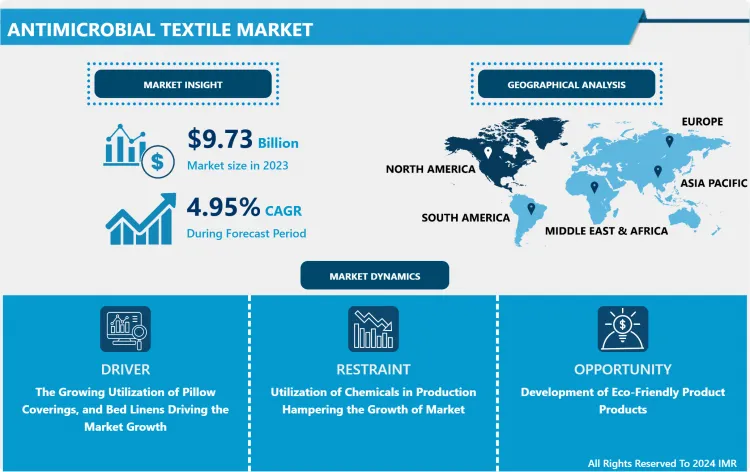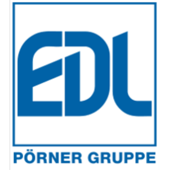Antimicrobial Textile Market Overview
Antimicrobial Textile Market size is expected to grow from USD 9.73 Billion in 2023 to USD 15.03 Billion by 2032, at a CAGR of 4.95% during the forecast period (2024-2032).
Antimicrobial textiles are specialized fabrics designed to kill or inhibit the growth of microorganisms, providing enhanced hygiene and cleanliness. These textiles incorporate natural or synthetic antimicrobial agents, such as silver ions, copper, or herbal extracts, to achieve their protective properties. The use of antimicrobial fabrics has gained significant traction across industries due to rising awareness of hygiene and infection control.
- One key advantage of antimicrobial textiles is their reduced need for frequent washing. Their resistance to bacteria and odors allows them to remain fresher for longer, saving water, energy, and time while reducing detergent use. This feature makes them particularly appealing for use in clothing, sportswear, and travel-related products. Additionally, their durable construction ensures that antimicrobial properties persist through multiple washes, maintaining their functionality over an extended period.
- The versatility of antimicrobial fabrics enables broad applications, ranging from personal apparel and home furnishings to critical healthcare items like hospital scrubs, bed linens, and surgical drapes. In medical environments, these fabrics provide an extra layer of defense against harmful pathogens, enhancing the safety of both patients and healthcare providers. Antimicrobial upholstery and curtains also help create cleaner public and private spaces.
- Despite their benefits, potential drawbacks exist. Some individuals may develop sensitivities to the chemical agents used in antimicrobial textiles, raising concerns about long-term exposure. As demand grows, balancing effectiveness, safety, and sustainability remains critical for the continued development of innovative antimicrobial fabric solutions.

COVID-19 Impact on Antimicrobial Textile Market
The outbreak of COVID-19 has resulted in the shutdown of various industries around the globe. Moreover, COVID-19 has generated awareness among individuals to practice the best hygienic methods for avoiding the microorganism spread. Due to the rise in the number of infections caused by bacteria and viruses such as SARS-CoV-2, the global demand for antimicrobial materials is increasing. Depending on different surfaces the stability of the virus varies and the virus may be able to transmit its pathogenicity for several days to weeks therefore, the demand for products having antimicrobial coatings is observing an unprecedented rise owing to the COVID-19 pandemic. The spread of COVID-19 has led to the widespread use of antimicrobial personal protective equipment or household fabric masks. Furthermore, antimicrobial fabrics can help to control the spread of microorganisms such as SARS-CoV-2 thus, there has been a rapid development in the preparation of antimicrobial fabrics. Due to restrictions imposed by governments on the transportation and gatherings of workers, there has been a significant reduction in the manufacturing of antimicrobial textiles. Due to worldwide lockdowns, the logistic systems were adversely affected which resulted in the delay of transportation of raw materials. To summarize the pandemic situation, COVID-19 has positively affected the growth of the antimicrobial market.
Market Dynamics And Key Factors In Antimicrobial Textile Market
Drivers:
The growing utilization of pillow coverings, curtains, and bed linens to make the house look better is the main factor driving the antimicrobial market growth. The changing consumer's attitude towards hygienic and healthy lifestyle has initiated a rapidly growing market for antimicrobial textiles, which in turn has encouraged intensive research and development to manufacture textiles having antimicrobial properties. To ensure a healthy and comfortable environment for people, several textile manufacturers are shifting towards the production of technical textiles and clothing with antimicrobial properties. Moreover, the care for human protection and the rapid development of health, safety, and environmental legislation has dynamically increased the technical textile market, like sutures, bandages, gauze, masks, surgical gowns, hospital linen, and specialized wound dressings.
Recent studies have illustrated that chitosan-based composites with silver nanoparticles, silver zeolite, or silver hydroxyapatite enhance the mechanical strength and water barrier properties of the textile. Furthermore, textiles containing silver nanoparticles can exert bactericidal effects and are less harmful to human cells than other toxic organic antimicrobial agents used in textile manufacturing. Additionally, metal oxide compounds such as ZnO nanoparticles have qualities like good photocatalytic activity, high stability, nontoxicity, and antibacterial properties, which has generated a wide interest for its application in the field of cosmetics, and protective medical clothes thus, supporting the expansion of antimicrobial textiles throughout the forecast.
Restraints:
The rapid increase in the demand for antimicrobial textiles has led to the usage of chemicals. Moreover, many of these chemicals utilized are toxic to human health and are not easily degraded in the natural environment, thus hampering the growth of the antimicrobial market in the period of forecast. Additionally, most antimicrobial agents administered in the production of textiles may suffer from the adverse mode of action such as action on non-target microorganisms. Furthermore, antimicrobial agents can pose a threat to the environment and have may have low-level durability of antimicrobial finish thus restraining the expansion of the antimicrobial market throughout the forecast. In certain instances, the use of antimicrobial agents has negatively impacted the effects of textile properties and appearances.
In certain cases, the organic compounds incorporated in textiles have resulted in skin problems such as rashes, swelling, reddening, allergies, and in rare cases may have carcinogenic effects on the skin. During the production of antimicrobial textiles, high amounts of solids, liquids, and gases are generated. Moreover, the textile industry uses a very huge amount of water which when released is contaminated with harmful chemicals, and microorganisms which can cause environmental complications, thus hindering the antimicrobial market expansion in the period of forecast. The volatility in the prices of raw materials, which are traded in the commodity market is one of the major factors declining the development of the antimicrobial market.
Opportunities:
Even though the antimicrobial textiles market is flooded with several antimicrobial agents, the textile industry continues to look for eco-friendly processes that can be carried out without toxic textile chemicals. The growing world population, rising living standards, and fast-moving fashion trends are the major opportunities for the market players as these factors are expected to offer a wide range of demands in antimicrobial textiles. The increasing prevalence of chronic diseases and the rise in hospital-acquired infections (HAI) are some factors that elevate the necessity of antimicrobial textiles. According to CDC, the cost of HAI in U.S hospitals is estimated to be at least US$ 28.4 billion each year and an additional cost of US$ 12.4 Billion to society from early deaths and lost productivity, thus promoting the market growth.
Segmentation Analysis of Antimicrobial Textile Market:
Depending on Active Agents, the antimicrobial textile market is segmented into synthetic organic compounds, metal and metallic salts, and bio-based compounds. Synthetic organic compounds are forecasted to have the highest share of the market. Synthetic organic compounds are manmade compounds that can increase the efficiency of the fabric to resist a wide range of microbes that can deteriorate the condition of the fabric, thus supporting the expansion of the synthetic organic compounds segment.
Depending on Fabric, the cotton segment is anticipated to dominate the antimicrobial market in the period of forecast. Cotton is the most widely used fabric for the preparation of various products such as apparel, masks, curtains, pillow coverings, and others. Qualities such as strength and absorbency make cotton an ideal fabric. The most vital benefit of cotton fabric is that it is breathable due to this, cotton sheets are the most preferred form of bedding material. Wearing cotton keeps skin cool during hot weather as well it doesn't retain the odor of the sweat thus, promoting the growth of the segment in the period of forecast.
Depending on Application, the medical textile segment is expected to lead the antimicrobial market during the period of forecast. The rise in the transmission of healthcare-associated infection is stimulating the growth of this segment. Moreover, to protect the staff involved in the healthcare industry from microbial infection it is has become necessary to provide them with apparel, that is resistant to the growth of bacteria, viruses, and other harmful microorganisms thus, encouraging the growth of the medical textile segment.
Regional Analysis of Antimicrobial Textile Market:
North America region is anticipated to dominate the antimicrobial market in the period of forecast. The growing technological advancements and their ready adoption to promote a hygienic and healthy lifestyle is promoting the expansion of the market in this region. The growing healthcare sector, presence of leading companies in this region is a major factor encouraging the market growth. The growing awareness of the benefits of antimicrobial textiles in preventing the spread of various types of diseases is leading to the high consumption of antimicrobial fabrics, thus supporting the expansion of the antimicrobial textile market.
North America followed by the Asia-Pacific region is predicted to have the second-highest share of the market. The huge populations in countries such as China and India and the growing need for antimicrobial fabrics in healthcare and daily use are stimulating the growth of the antimicrobial’s textiles market in this region. The rapidly growing fashion trend, changing lifestyles, high disposable income is further propelling the growth of the antimicrobial market in this region.
The European region is expected to have a significant growth rate in the forecast period. The well-deployed healthcare sector and their ever-growing demand for antimicrobial fabrics are the main factors driving the market growth. The presence of leading medical institutions, manufacturers, and supportive government policies are some factors supporting the market growth in this region.
Players Covered in Antimicrobial Textile market are :
- Balavigna Mills Pvt. Ltd. (India)
- BASF SE (Germany)
- Biocote Limited (UK)
- DUPONT (US)
- Eysan Fabrics Co. Ltd. (Taiwan)
- HeiQ Materials AG (Switzerland)
- Herculite (US)
- Life threads (US)
- Lonza Group Ltd (Switzerland)
- Microban International (US)
- Milliken Chemical (US)
- NanoHorizons (US)
- Purthread Technologies Inc. (US)
- Resil Chemicals Pvt. Ltd (India)
- Sanitized AG (Switzerland)
- Sciessent LLC (US)
- Smartfiber AG (Germany)
- Thomson Research Associates (Canada)
- Trevira GmbH (Germany)
- Unitika Ltd (Japan)
- VESTEX (US) and others Major key players.
Key Industry Developments In Antimicrobial Textile Market
- In October 2024, 1888 Mills, a prominent global textile manufacturer, announced its partnership with FUZE Technologies (FUZE), a pioneer in antimicrobial textile treatment. This collaboration aimed to revolutionize hygiene and efficiency in textiles used across hotels and commercial properties. FUZE™ F1, a chemical-free, water-based solution, offered unmatched durability by permanently adhering to materials without binders or surfactants. Proven to last beyond 100 washes, even through intense commercial laundering, FUZE™ F1 set a new benchmark for antimicrobial performance.
- In November 24, 2023, Polygiene Group introduced a groundbreaking, plant-based antimicrobial technology for the textile market. The company secured a three-year exclusive distribution agreement with French biotech firm Proneem, granting access to innovative technology that complements Polygiene’s existing odor control solutions. The bio-based active ingredient, derived from plant substances, aligns with the demand for metal-free antimicrobial additives. This natural organic acid, commonly used in food, pharmaceuticals, and cosmetics, offers a unique first-to-market product.
|
Antimicrobial Textile Market |
|||
|
Base Year: |
2023 |
Forecast Period: |
2024-2032 |
|
Historical Data: |
2017 to 2023 |
Market Size in 2023: |
USD 9.73 Bn. |
|
Forecast Period 2024-32 CAGR: |
4.95% |
Market Size in 2032: |
USD 15.03 Bn. |
|
Segments Covered: |
By Type |
|
|
|
By Fabric |
|
||
|
By Application |
|
||
|
By Region |
|
||
|
Key Market Drivers: |
|
||
|
Key Market Restraints: |
|
||
|
Key Opportunities: |
|
||
|
Companies Covered in the report: |
|
||
Chapter 1: Introduction
1.1 Research Objectives
1.2 Research Methodology
1.3 Research Process
1.4 Scope and Coverage
1.4.1 Market Definition
1.4.2 Key Questions Answered
1.5 Market Segmentation
Chapter 2:Executive Summary
Chapter 3:Growth Opportunities By Segment
3.1 By Type
3.2 By Fabric
3.3 By Application
Chapter 4: Market Landscape
4.1 Porter's Five Forces Analysis
4.1.1 Bargaining Power of Supplier
4.1.2 Threat of New Entrants
4.1.3 Threat of Substitutes
4.1.4 Competitive Rivalry
4.1.5 Bargaining Power Among Buyers
4.2 Industry Value Chain Analysis
4.3 Market Dynamics
4.3.1 Drivers
4.3.2 Restraints
4.3.3 Opportunities
4.5.4 Challenges
4.4 Pestle Analysis
4.5 Technological Roadmap
4.6 Regulatory Landscape
4.7 SWOT Analysis
4.8 Price Trend Analysis
4.9 Patent Analysis
4.10 Analysis of the Impact of Covid-19
4.10.1 Impact on the Overall Market
4.10.2 Impact on the Supply Chain
4.10.3 Impact on the Key Manufacturers
4.10.4 Impact on the Pricing
Chapter 5: Antimicrobial Textile Market by Type
5.1 Antimicrobial Textile Market Overview Snapshot and Growth Engine
5.2 Antimicrobial Textile Market Overview
5.3 Synthetic Organic Compounds
5.3.1 Introduction and Market Overview
5.3.2 Historic and Forecasted Market Size (2017-2032F)
5.3.3 Key Market Trends, Growth Factors and Opportunities
5.3.4 Synthetic Organic Compounds: Grographic Segmentation
5.4 Metal & Metallic Salts
5.4.1 Introduction and Market Overview
5.4.2 Historic and Forecasted Market Size (2017-2032F)
5.4.3 Key Market Trends, Growth Factors and Opportunities
5.4.4 Metal & Metallic Salts: Grographic Segmentation
5.5 Bio-based
5.5.1 Introduction and Market Overview
5.5.2 Historic and Forecasted Market Size (2017-2032F)
5.5.3 Key Market Trends, Growth Factors and Opportunities
5.5.4 Bio-based: Grographic Segmentation
Chapter 6: Antimicrobial Textile Market by Fabric
6.1 Antimicrobial Textile Market Overview Snapshot and Growth Engine
6.2 Antimicrobial Textile Market Overview
6.3 Cotton
6.3.1 Introduction and Market Overview
6.3.2 Historic and Forecasted Market Size (2017-2032F)
6.3.3 Key Market Trends, Growth Factors and Opportunities
6.3.4 Cotton: Grographic Segmentation
6.4 Polyester
6.4.1 Introduction and Market Overview
6.4.2 Historic and Forecasted Market Size (2017-2032F)
6.4.3 Key Market Trends, Growth Factors and Opportunities
6.4.4 Polyester: Grographic Segmentation
6.5 Polyamide
6.5.1 Introduction and Market Overview
6.5.2 Historic and Forecasted Market Size (2017-2032F)
6.5.3 Key Market Trends, Growth Factors and Opportunities
6.5.4 Polyamide: Grographic Segmentation
6.6 Wool
6.6.1 Introduction and Market Overview
6.6.2 Historic and Forecasted Market Size (2017-2032F)
6.6.3 Key Market Trends, Growth Factors and Opportunities
6.6.4 Wool: Grographic Segmentation
6.7 Others
6.7.1 Introduction and Market Overview
6.7.2 Historic and Forecasted Market Size (2017-2032F)
6.7.3 Key Market Trends, Growth Factors and Opportunities
6.7.4 Others: Grographic Segmentation
Chapter 7: Antimicrobial Textile Market by Application
7.1 Antimicrobial Textile Market Overview Snapshot and Growth Engine
7.2 Antimicrobial Textile Market Overview
7.3 Medical Textiles
7.3.1 Introduction and Market Overview
7.3.2 Historic and Forecasted Market Size (2017-2032F)
7.3.3 Key Market Trends, Growth Factors and Opportunities
7.3.4 Medical Textiles: Grographic Segmentation
7.4 Apparels
7.4.1 Introduction and Market Overview
7.4.2 Historic and Forecasted Market Size (2017-2032F)
7.4.3 Key Market Trends, Growth Factors and Opportunities
7.4.4 Apparels: Grographic Segmentation
7.5 Home Textiles
7.5.1 Introduction and Market Overview
7.5.2 Historic and Forecasted Market Size (2017-2032F)
7.5.3 Key Market Trends, Growth Factors and Opportunities
7.5.4 Home Textiles: Grographic Segmentation
7.6 Others
7.6.1 Introduction and Market Overview
7.6.2 Historic and Forecasted Market Size (2017-2032F)
7.6.3 Key Market Trends, Growth Factors and Opportunities
7.6.4 Others: Grographic Segmentation
Chapter 8: Company Profiles and Competitive Analysis
8.1 Competitive Landscape
8.1.1 Competitive Positioning
8.1.2 Antimicrobial Textile Sales and Market Share By Players
8.1.3 Industry BCG Matrix
8.1.4 Ansoff Matrix
8.1.5 Antimicrobial Textile Industry Concentration Ratio (CR5 and HHI)
8.1.6 Top 5 Antimicrobial Textile Players Market Share
8.1.7 Mergers and Acquisitions
8.1.8 Business Strategies By Top Players
8.2 BALAVIGNA MILLS PVT. LTD.
8.2.1 Company Overview
8.2.2 Key Executives
8.2.3 Company Snapshot
8.2.4 Operating Business Segments
8.2.5 Product Portfolio
8.2.6 Business Performance
8.2.7 Key Strategic Moves and Recent Developments
8.2.8 SWOT Analysis
8.3 BASF SE
8.4 BIOCOTE LIMITED
8.5 DUPONT
8.6 EYSAN FABRICS CO. LTD.
8.7 HEIQ MATERIALS AG
8.8 HERCULITE
8.9 LIFE THREADS
8.10 LONZA GROUP LTD
8.11 MICROBAN INTERNATIONAL
8.12 MILLIKEN CHEMICAL
8.13 NANOHORIZONS
8.14 PURTHREAD TECHNOLOGIES INC.
8.15 RESIL CHEMICALS PVT. LTD
8.16 SANITIZED AG
8.17 SCIESSENT LLC
8.18 SMARTFIBER AG
8.19 THOMSON RESEARCH ASSOCIATES
8.20 TREVIRA GMBH
8.21 UNITIKA LTD
8.22 VESTEX
8.23 OTHER MAJOR PLAYERS
Chapter 9: Global Antimicrobial Textile Market Analysis, Insights and Forecast, 2017-2032
9.1 Market Overview
9.2 Historic and Forecasted Market Size By Type
9.2.1 Synthetic Organic Compounds
9.2.2 Metal & Metallic Salts
9.2.3 Bio-based
9.3 Historic and Forecasted Market Size By Fabric
9.3.1 Cotton
9.3.2 Polyester
9.3.3 Polyamide
9.3.4 Wool
9.3.5 Others
9.4 Historic and Forecasted Market Size By Application
9.4.1 Medical Textiles
9.4.2 Apparels
9.4.3 Home Textiles
9.4.4 Others
Chapter 10: North America Antimicrobial Textile Market Analysis, Insights and Forecast, 2017-2032
10.1 Key Market Trends, Growth Factors and Opportunities
10.2 Impact of Covid-19
10.3 Key Players
10.4 Key Market Trends, Growth Factors and Opportunities
10.4 Historic and Forecasted Market Size By Type
10.4.1 Synthetic Organic Compounds
10.4.2 Metal & Metallic Salts
10.4.3 Bio-based
10.5 Historic and Forecasted Market Size By Fabric
10.5.1 Cotton
10.5.2 Polyester
10.5.3 Polyamide
10.5.4 Wool
10.5.5 Others
10.6 Historic and Forecasted Market Size By Application
10.6.1 Medical Textiles
10.6.2 Apparels
10.6.3 Home Textiles
10.6.4 Others
10.7 Historic and Forecast Market Size by Country
10.7.1 U.S.
10.7.2 Canada
10.7.3 Mexico
Chapter 11: Europe Antimicrobial Textile Market Analysis, Insights and Forecast, 2017-2032
11.1 Key Market Trends, Growth Factors and Opportunities
11.2 Impact of Covid-19
11.3 Key Players
11.4 Key Market Trends, Growth Factors and Opportunities
11.4 Historic and Forecasted Market Size By Type
11.4.1 Synthetic Organic Compounds
11.4.2 Metal & Metallic Salts
11.4.3 Bio-based
11.5 Historic and Forecasted Market Size By Fabric
11.5.1 Cotton
11.5.2 Polyester
11.5.3 Polyamide
11.5.4 Wool
11.5.5 Others
11.6 Historic and Forecasted Market Size By Application
11.6.1 Medical Textiles
11.6.2 Apparels
11.6.3 Home Textiles
11.6.4 Others
11.7 Historic and Forecast Market Size by Country
11.7.1 Germany
11.7.2 U.K.
11.7.3 France
11.7.4 Italy
11.7.5 Russia
11.7.6 Spain
11.7.7 Rest of Europe
Chapter 12: Asia-Pacific Antimicrobial Textile Market Analysis, Insights and Forecast, 2017-2032
12.1 Key Market Trends, Growth Factors and Opportunities
12.2 Impact of Covid-19
12.3 Key Players
12.4 Key Market Trends, Growth Factors and Opportunities
12.4 Historic and Forecasted Market Size By Type
12.4.1 Synthetic Organic Compounds
12.4.2 Metal & Metallic Salts
12.4.3 Bio-based
12.5 Historic and Forecasted Market Size By Fabric
12.5.1 Cotton
12.5.2 Polyester
12.5.3 Polyamide
12.5.4 Wool
12.5.5 Others
12.6 Historic and Forecasted Market Size By Application
12.6.1 Medical Textiles
12.6.2 Apparels
12.6.3 Home Textiles
12.6.4 Others
12.7 Historic and Forecast Market Size by Country
12.7.1 China
12.7.2 India
12.7.3 Japan
12.7.4 Singapore
12.7.5 Australia
12.7.6 New Zealand
12.7.7 Rest of APAC
Chapter 13: Middle East & Africa Antimicrobial Textile Market Analysis, Insights and Forecast, 2017-2032
13.1 Key Market Trends, Growth Factors and Opportunities
13.2 Impact of Covid-19
13.3 Key Players
13.4 Key Market Trends, Growth Factors and Opportunities
13.4 Historic and Forecasted Market Size By Type
13.4.1 Synthetic Organic Compounds
13.4.2 Metal & Metallic Salts
13.4.3 Bio-based
13.5 Historic and Forecasted Market Size By Fabric
13.5.1 Cotton
13.5.2 Polyester
13.5.3 Polyamide
13.5.4 Wool
13.5.5 Others
13.6 Historic and Forecasted Market Size By Application
13.6.1 Medical Textiles
13.6.2 Apparels
13.6.3 Home Textiles
13.6.4 Others
13.7 Historic and Forecast Market Size by Country
13.7.1 Turkey
13.7.2 Saudi Arabia
13.7.3 Iran
13.7.4 UAE
13.7.5 Africa
13.7.6 Rest of MEA
Chapter 14: South America Antimicrobial Textile Market Analysis, Insights and Forecast, 2017-2032
14.1 Key Market Trends, Growth Factors and Opportunities
14.2 Impact of Covid-19
14.3 Key Players
14.4 Key Market Trends, Growth Factors and Opportunities
14.4 Historic and Forecasted Market Size By Type
14.4.1 Synthetic Organic Compounds
14.4.2 Metal & Metallic Salts
14.4.3 Bio-based
14.5 Historic and Forecasted Market Size By Fabric
14.5.1 Cotton
14.5.2 Polyester
14.5.3 Polyamide
14.5.4 Wool
14.5.5 Others
14.6 Historic and Forecasted Market Size By Application
14.6.1 Medical Textiles
14.6.2 Apparels
14.6.3 Home Textiles
14.6.4 Others
14.7 Historic and Forecast Market Size by Country
14.7.1 Brazil
14.7.2 Argentina
14.7.3 Rest of SA
Chapter 15 Investment Analysis
Chapter 16 Analyst Viewpoint and Conclusion
|
Antimicrobial Textile Market |
|||
|
Base Year: |
2023 |
Forecast Period: |
2024-2032 |
|
Historical Data: |
2017 to 2023 |
Market Size in 2023: |
USD 9.73 Bn. |
|
Forecast Period 2024-32 CAGR: |
4.95% |
Market Size in 2032: |
USD 15.03 Bn. |
|
Segments Covered: |
By Type |
|
|
|
By Fabric |
|
||
|
By Application |
|
||
|
By Region |
|
||
|
Key Market Drivers: |
|
||
|
Key Market Restraints: |
|
||
|
Key Opportunities: |
|
||
|
Companies Covered in the report: |
|
||
Frequently Asked Questions :
The forecast period in the Antimicrobial Textile Market research report is 2024-2032.
Balavigna Mills Pvt. Ltd. (India), BASF SE (Germany), Biocote Limited (UK), DUPONT (US), Eysan Fabrics Co. Ltd. (Taiwan), HeiQ Materials AG (Switzerland), Herculite (US), Life threads (US), Lonza Group Ltd (Switzerland), Microban International (US), Milliken Chemical (US), NanoHorizons (US), Purthread Technologies Inc. (US), Resil Chemicals Pvt. Ltd (India), Sanitized AG (Switzerland), Sciessent LLC (US), Smartfiber AG (Germany), Thomson Research Associates (Canada), Trevira GmbH (Germany), Unitika Ltd (Japan), VESTEX (US), and Other Major Players.
Antimicrobial Textile Market is segmented into Type, Fabric, Application and region. By Type, the market is categorized into Synthetic Organic Compounds, Metal & Metallic Salts, Bio-based. By Fabric, the market is categorized into Cotton, Polyester, Polyamide, Wool, Others. By Application, the market is categorized into Medical Textiles, Apparels, Home Textiles, Others. By region, it is analysed across North America (U.S.; Canada; Mexico), Europe (Germany; U.K.; France; Italy; Russia; Spain, etc.), Asia-Pacific (China; India; Japan; Southeast Asia, etc.), South America (Brazil; Argentina, etc.), Middle East & Africa (Saudi Arabia; South Africa, etc.).
The Textile industry had considered enhancing antimicrobial fibers, as people became aware of the fact that textile could protect the wearers against the spread of bacteria and diseases.
The Global Antimicrobial Textile Market size is expected to grow from USD 9.73 Billion in 2023 to USD 15.03 Billion by 2032, at a CAGR of 4.95% during the forecast period (2024-2032).















